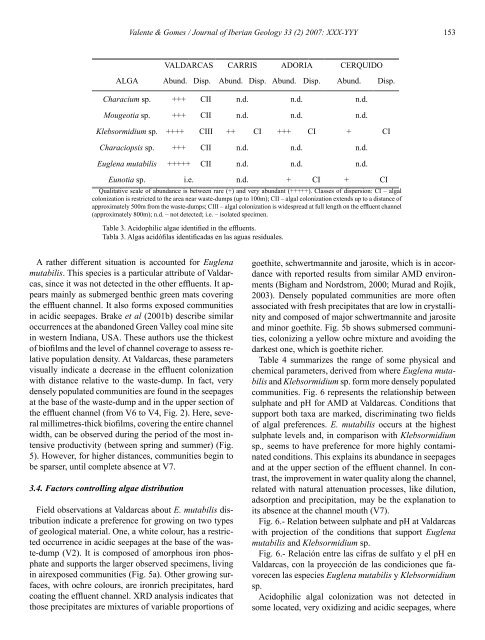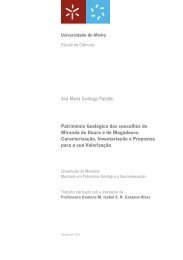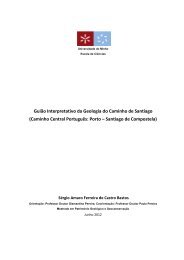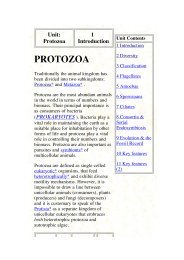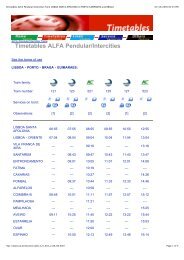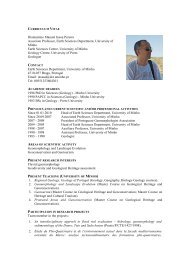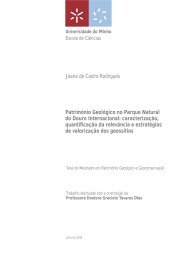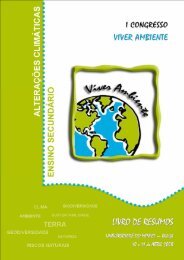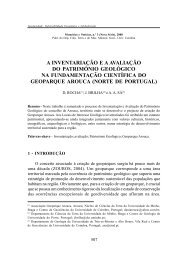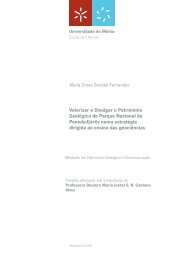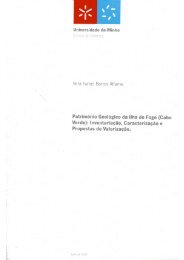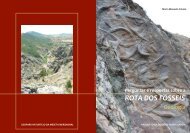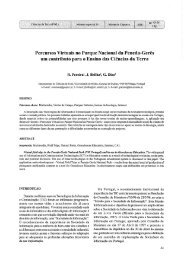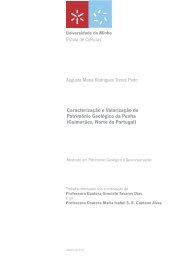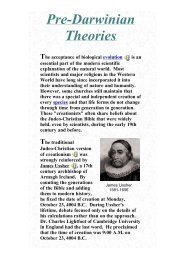Descarregue o Livro do Curso a partir daqui - Departamento de ...
Descarregue o Livro do Curso a partir daqui - Departamento de ...
Descarregue o Livro do Curso a partir daqui - Departamento de ...
Create successful ePaper yourself
Turn your PDF publications into a flip-book with our unique Google optimized e-Paper software.
Valente & Gomes / Journal of Iberian Geology 33 (2) 2007: XXX-YYY<br />
153<br />
VALDARCAS CARRIS ADORIA CERQUIDO<br />
ALGA Abund. Disp. Abund. Disp. Abund. Disp. Abund. Disp.<br />
Characium sp. +++ CII n.d. n.d. n.d.<br />
Mougeotia sp. +++ CII n.d. n.d. n.d.<br />
Klebsormidium sp. ++++ CIII ++ CI +++ CI + CI<br />
Characiopsis sp. +++ CII n.d. n.d. n.d.<br />
Euglena mutabilis +++++ CII n.d. n.d. n.d.<br />
Eunotia sp. i.e. n.d. + CI + CI<br />
Qualitative scale of abundance is between rare (+) and very abundant (+++++). Classes of dispersion: CI – algal<br />
colonization is restricted to the area near waste-dumps (up to 100m); CII – algal colonization extends up to a distance of<br />
approximately 500m from the waste-dumps; CIII – algal colonization is wi<strong>de</strong>spread at full length on the effluent channel<br />
(approximately 800m); n.d. – not <strong>de</strong>tected; i.e. – isolated specimen.<br />
Table 3. Aci<strong>do</strong>philic algae i<strong>de</strong>ntified in the effluents.<br />
Tabla 3. Algas acidófilas i<strong>de</strong>ntificadas en las aguas residuales.<br />
A rather different situation is accounted for Euglena<br />
mutabilis. This species is a particular attribute of Valdarcas,<br />
since it was not <strong>de</strong>tected in the other effluents. It appears<br />
mainly as submerged benthic green mats covering<br />
the effluent channel. It also forms exposed communities<br />
in acidic seepages. Brake et al (2001b) <strong>de</strong>scribe similar<br />
occurrences at the aban<strong>do</strong>ned Green Valley coal mine site<br />
in western Indiana, USA. These authors use the thickest<br />
of biofilms and the level of channel coverage to assess relative<br />
population <strong>de</strong>nsity. At Valdarcas, these parameters<br />
visually indicate a <strong>de</strong>crease in the effluent colonization<br />
with distance relative to the waste-dump. In fact, very<br />
<strong>de</strong>nsely populated communities are found in the seepages<br />
at the base of the waste-dump and in the upper section of<br />
the effluent channel (from V6 to V4, Fig. 2). Here, several<br />
millimetres-thick biofilms, covering the entire channel<br />
width, can be observed during the period of the most intensive<br />
productivity (between spring and summer) (Fig.<br />
5). However, for higher distances, communities begin to<br />
be sparser, until complete absence at V7.<br />
3.4. Factors controlling algae distribution<br />
Field observations at Valdarcas about E. mutabilis distribution<br />
indicate a preference for growing on two types<br />
of geological material. One, a white colour, has a restricted<br />
occurrence in acidic seepages at the base of the waste-dump<br />
(V2). It is composed of amorphous iron phosphate<br />
and supports the larger observed specimens, living<br />
in airexposed communities (Fig. 5a). Other growing surfaces,<br />
with ochre colours, are ironrich precipitates, hard<br />
coating the effluent channel. XRD analysis indicates that<br />
those precipitates are mixtures of variable proportions of<br />
goethite, schwertmannite and jarosite, which is in accordance<br />
with reported results from similar AMD environments<br />
(Bigham and Nordstrom, 2000; Murad and Rojík,<br />
2003). Densely populated communities are more often<br />
associated with fresh precipitates that are low in crystallinity<br />
and composed of major schwertmannite and jarosite<br />
and minor goethite. Fig. 5b shows submersed communities,<br />
colonizing a yellow ochre mixture and avoiding the<br />
darkest one, which is goethite richer.<br />
Table 4 summarizes the range of some physical and<br />
chemical parameters, <strong>de</strong>rived from where Euglena mutabilis<br />
and Klebsormidium sp. form more <strong>de</strong>nsely populated<br />
communities. Fig. 6 represents the relationship between<br />
sulphate and pH for AMD at Valdarcas. Conditions that<br />
support both taxa are marked, discriminating two fields<br />
of algal preferences. E. mutabilis occurs at the highest<br />
sulphate levels and, in comparison with Klebsormidium<br />
sp., seems to have preference for more highly contaminated<br />
conditions. This explains its abundance in seepages<br />
and at the upper section of the effluent channel. In contrast,<br />
the improvement in water quality along the channel,<br />
related with natural attenuation processes, like dilution,<br />
adsorption and precipitation, may be the explanation to<br />
its absence at the channel mouth (V7).<br />
Fig. 6.- Relation between sulphate and pH at Valdarcas<br />
with projection of the conditions that support Euglena<br />
mutabilis and Klebsormidium sp.<br />
Fig. 6.- Relación entre las cifras <strong>de</strong> sulfato y el pH en<br />
Valdarcas, con la proyección <strong>de</strong> las condiciones que favorecen<br />
las especies Euglena mutabilis y Klebsormidium<br />
sp.<br />
Aci<strong>do</strong>philic algal colonization was not <strong>de</strong>tected in<br />
some located, very oxidizing and acidic seepages, where


